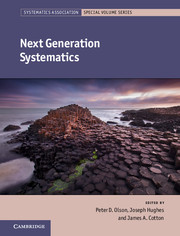Book contents
- Frontmatter
- Contents
- List of contributors
- Introduction: studying diversity in an era of ubiquitous genomics
- Part I Next Generation Phylogenetics
- Part II Next Generation Biodiversity Science
- Part III Next Generation Challenges and Questions
- 10 Perspective: Systematics in the age of genomics
- 11 Perspective: The role of next generation sequencing for integrative approaches in evolutionary biology
- 12 Next generation apomorphy: the ubiquity of taxonomically restricted genes
- 13 Utilizing next generation sequencing for evo-devo study of plant traits
- 14 An NGS approach to archaeobotanical museum specimens as genetic resources in systematics research
- 15 From sequence reads to evolutionary inferences
- Index
- Systematics Association Special Volumes
- Plate section
- References
12 - Next generation apomorphy: the ubiquity of taxonomically restricted genes
from Part III - Next Generation Challenges and Questions
Published online by Cambridge University Press: 05 June 2016
- Frontmatter
- Contents
- List of contributors
- Introduction: studying diversity in an era of ubiquitous genomics
- Part I Next Generation Phylogenetics
- Part II Next Generation Biodiversity Science
- Part III Next Generation Challenges and Questions
- 10 Perspective: Systematics in the age of genomics
- 11 Perspective: The role of next generation sequencing for integrative approaches in evolutionary biology
- 12 Next generation apomorphy: the ubiquity of taxonomically restricted genes
- 13 Utilizing next generation sequencing for evo-devo study of plant traits
- 14 An NGS approach to archaeobotanical museum specimens as genetic resources in systematics research
- 15 From sequence reads to evolutionary inferences
- Index
- Systematics Association Special Volumes
- Plate section
- References
Summary
Introduction
The ability to sequence whole genomes at ever-increasing rates has led to the discovery of vast numbers of genes that are unique to each taxon (i.e. apomorphic genes). Before the advent of automated DNA sequencing in the early 1990s, genetic comparison of organisms was only feasible through the targeted amplification of homologous genes shared among divergent taxa, and reliable identification of taxon-specific genes was almost impossible. Shortly after the publication of the first whole genome in 1995, it became clear that species possessed many more taxonomically unique, or restricted, gene sequences than expected. When seven whole genomes had been published, R. F. Doolittle, a molecular biologist of many decades’ experience, commented: ‘I am surprised that so many open reading frames remain as unidentified [i.e. unique] reading frames’ (Doolittle 1997, p. 516). Five years later, when 60 whole genomes had been sequenced, he called taxonomically unique sequences ‘the biggest surprise in genome sequencing’ (Doolittle 2002, p. 698).
Today, with whole-genome sequencing further facilitated by next generation technologies, these taxonomically restricted genes (TRGs; Khalturin et al. 2009), also known as orphan genes (Dujon 1996), or ‘ORFans’ (Fischer and Eisenberg 1999) continue to be discovered in every newly sequenced species genome (Figs 12.1 and 12.2). These genes represent one of the most intriguing aspects of systematics, lying at the intersection of genomics, genetics, comparative and structural biology, phylogenetics and evolution. Yet, by their very nature, they are difficult to study using conventional comparative approaches and attract little research funding.
In this chapter, we review the current status of this conundrum in the light of rapid advances in genomics. Section 12.2 examines the definition of TRGs/ORFans, noting that this is an inherently comparative concept and the status of any gene as a TRG/ORFan is therefore highly contingent. Section 12.3 emphasizes their ubiquity. Section 12.4 discusses the biological significance of some TRGs in terms of putative functions. Section 12.5 discusses hypotheses for the origins and evolution of TRGs, and finally Section 12.6 examines the relevance of TRGs to systematics.
The contingent nature of TRG classification
Assigning any gene the status of ‘taxonomically restricted’ or ‘orphan’ is necessarily a relative judgement; an ‘orphan’ gene always holds its status provisionally.
- Type
- Chapter
- Information
- Next Generation Systematics , pp. 237 - 263Publisher: Cambridge University PressPrint publication year: 2016

